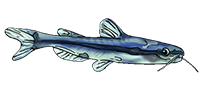
What Scobinancistrus is this?
What Scobinancistrus is this?
Does anyone know what Scobinancistrus is this? L-48 or 362 or 368? Are they all S. pariolispos?


Scobinancistrus auratus is my favorite pleco ^_^
- apistomaster
- Posts: 4735
- Joined: 10 Jun 2006, 14:26
- I've donated: $90.00!
- My articles: 1
- My cats species list: 12 (i:0, k:0)
- My Wishlist: 1
- Location 1: Clarkston, WA, USA
- Location 2: Clarkston, WA, USA
- Interests: Aquaculture and flyfishing
- MatsP
- Posts: 21038
- Joined: 06 Oct 2004, 13:58
- My articles: 4
- My images: 28
- My cats species list: 117 (i:33, k:0)
- My aquaria list: 12 (i:10)
- My BLogs: 4 (i:0, p:164)
- Spotted: 187
- Location 1: North of Cambridge
- Location 2: England.
The only real difference between these L-numbers and S. parliospos is their capture location. L362 is from Rio Jamanxim, which is a tributary to Rio Tocantins.
From the pictures here, L368 appears to have much larger spots, but it could be that it's just a juvenile - just like young L14's have larger spots than mature adults...
The best way to determine which L-number (or species) of the fish is to know the capture location. Really good wholesalers (and thus shops buying from those wholesalers) will be able to tell you which river the fish came from, but most won't
--
Mats
From the pictures here, L368 appears to have much larger spots, but it could be that it's just a juvenile - just like young L14's have larger spots than mature adults...
The best way to determine which L-number (or species) of the fish is to know the capture location. Really good wholesalers (and thus shops buying from those wholesalers) will be able to tell you which river the fish came from, but most won't
--
Mats
- MatsP
- Posts: 21038
- Joined: 06 Oct 2004, 13:58
- My articles: 4
- My images: 28
- My cats species list: 117 (i:33, k:0)
- My aquaria list: 12 (i:10)
- My BLogs: 4 (i:0, p:164)
- Spotted: 187
- Location 1: North of Cambridge
- Location 2: England.
Yes, both Scobinancistrus and Baryancistrus seem to have a "higher number of smaller spots" as they grow older.
Searching the Web for L368 images only reveals the ones in the Cat-eLog, so I guess there aren't that many.
DATZ says that the L368 is from Rio Tocantins, so the same general area of Brazil, but not the same river as S. parliospos or L362.
http://www.transfish.de has a picture of L362, but it looks like the same fish as the L362 picture in the Cat-eLog (and the one in DATZ).
--
Mats
Searching the Web for L368 images only reveals the ones in the Cat-eLog, so I guess there aren't that many.
DATZ says that the L368 is from Rio Tocantins, so the same general area of Brazil, but not the same river as S. parliospos or L362.
http://www.transfish.de has a picture of L362, but it looks like the same fish as the L362 picture in the Cat-eLog (and the one in DATZ).
--
Mats
That's the reason why I ask here 


L-48 seems to be from Xingu, so S. pariolispos may be just the L-362 and L-368 if there is any real difference between them. That doesn't help id the fish in question though, since white/light yellow or light orange spots version of juv L-48 seems similar to juv L-362 and L-368...
L-48 seems to be from Xingu, so S. pariolispos may be just the L-362 and L-368 if there is any real difference between them. That doesn't help id the fish in question though, since white/light yellow or light orange spots version of juv L-48 seems similar to juv L-362 and L-368...
Scobinancistrus auratus is my favorite pleco ^_^
- MatsP
- Posts: 21038
- Joined: 06 Oct 2004, 13:58
- My articles: 4
- My images: 28
- My cats species list: 117 (i:33, k:0)
- My aquaria list: 12 (i:10)
- My BLogs: 4 (i:0, p:164)
- Spotted: 187
- Location 1: North of Cambridge
- Location 2: England.
Yes, I understand why you ask, and I would also agree that they are most likely the same species. But until some scientist has actually compared them and written a scientific paper on the subject, we can't say for sure.
Of course, even if they are the same species, there may be a good reason to not "mix them" if you plan on breeding them - just like different forms of other fish shouldn't really be mixed - Tropheus are one of those that have many different colour forms within a species, and in my opinion, they should be bred within their own form.
--
Mats
Of course, even if they are the same species, there may be a good reason to not "mix them" if you plan on breeding them - just like different forms of other fish shouldn't really be mixed - Tropheus are one of those that have many different colour forms within a species, and in my opinion, they should be bred within their own form.
--
Mats
The problem is that there is no way to get locality of this Scobinancistrus from the seller, and I would like to find where are they from... Is there any way to differentiate L-48 from L-362 or L-368?
+++addition+++ After checking Rio Jamanxim flows into Tapajos, So it may be possible that L-362 is the same as L-368? Since L-48 is from Xingu does this mean S. pariolispos from Rio Tocantins has not yet been exported?
+++addition+++ After checking Rio Jamanxim flows into Tapajos, So it may be possible that L-362 is the same as L-368? Since L-48 is from Xingu does this mean S. pariolispos from Rio Tocantins has not yet been exported?
Scobinancistrus auratus is my favorite pleco ^_^





